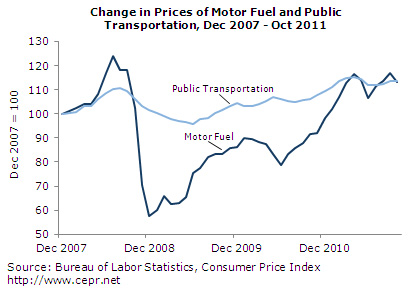November 16, 2011
November 16, 2011 (Prices Byte)
Producer price inflation is slowing and prices are falling at earlier stages of production.
Consumer prices fell 0.1 percent in October, though it rose at a 2.4 percent annualized rate over the last three months. In the last six months, the rate of inflation in the Consumer Price Index ran at 2.1 percent, compared with 5.1 percent in the six months ending in April. Overwhelmingly, this is due to a fall in energy prices, which have dropped at a 3.2 percent annualized rate compared with a 35.0 percent annualized rate of increase the six months prior.
For the second consecutive month, core consumer prices rose 0.1 percent, following two months of 0.2 percent gains, and 0.3 percent gains in May and June. As a result, the core rate of inflation has run 2.2 percent over the last three months compared with a still-modest 3.2 percent in the three months prior.
Within core prices, rents rose 0.4 percent in October. The rate of inflation in rent has accelerated as of late—3.8 percent annualized over the last four months, compared with 1.3 percent from February to June. However, rent does at times include utilities, so much of this inflation may be a passing along of landlord energy costs, rather than a tightening of the housing market. Owners’ equivalent rent—which does not include any utilities—rose only 0.2 percent in October, and at a 2.4 percent annualized rate over the last three months.
Elsewhere, transportation prices fell 1.1 percent, broadly reversing last month’s rise of 1.0 percent. Though much of the fall was related to the reversal in the price of gasoline, the price of new vehicles fell 0.3 percent and the price of used cars and trucks fell 0.6 percent for the second consecutive month. Public transportation prices also often reflect changes in energy costs, and so airline fares fell 0.1 percent in October, compared with gains of 1.0 percent in September and 1.1 percent in August.

Inflation in medical care is again running above core prices generally. Though medical care accounts for less than 10 percent of the core index, it has seen prices rise 0.5 percent in October and a 3.7 percent annualized rate of inflation over the last three months.
Education prices have also been a source of core price inflation, increasing at a 4.4 percent annualized rate over the last six months. Textbook prices have risen particularly fast—5.4 percent annualized since April, and 6.3 percent annualized in the six months previous to that. Core prices on the whole rose at 2.4 and 1.8 percent annualized rates, respectively, over those periods.
Inflation pressures have also eased at earlier stages of production. Though producer energy prices fell again in October, so did core producer prices. The index of core finished producer prices was unchanged in the month and has grown at a 1.1 percent annualized rate over the last three months. Similarly, core intermediate goods fell 0.6 percent and fell at a 2.0 percent rate since July and core crude goods fell 4.3 percent and are down at a 3.0 percent rate over the last six months.
Core import prices fell 0.2 percent in October and have risen at a 1.6 percent annualized rate over the last three months compared with 3.6 percent from April to July. October’s fall in import prices was very broadly-based, except for a 1.5 percent rise in manufactured consumer nondurable goods. This was overwhelmingly due to a sudden 4.9 percent jump in the price of pharmaceutical imports. Despite the October increase in pharmaceutical prices, they have risen only 2.4 percent over the last year.
Core export prices also fell 1.0 percent last month and at a 1.9 percent annualized rate since the dollar bottomed out in July—compared with 2.4 percent over the three months prior.
With the dollar rebounding in recent months amidst troubles in Europe, trade prices falling, and producer prices slackening at all stages of production, there are few signs of inflation. Even with this month’s fall in energy prices, the real average hourly wage has lagged consumer prices at a 1.2 percent annualized rate over the last three months. Absent increased demand for goods and services domestically and abroad, inflation is not soon likely to pose a problem for the economy.






